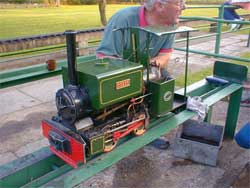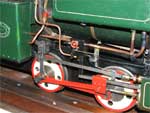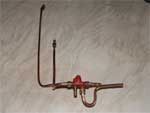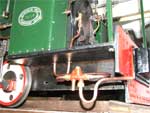
ORIGINS
Dixie was purchased in 2003 following the untimely death of her former owner and fellow club member Mr Bob Anderson. Bob had purchased the loco a couple of years before from Maxitrak (at least second hand) who must have bought it back or taken it in part exchange, nothing is known of her prior history. At purchase she had not been run for some time and her boiler certificate had expired. Following purchase hydraulic and steam tests were carried out prior to a test run. Whilst she ran satisfactorily there were several niggling problems. The displacement type lubricator was very temperamental in operation either delivering vast quantities of oil or none at all, there was a severe and persistant leak from the crosshead pump despite repacking the gland and the hand pump was very slow in delivery. The picture below show's Dixie with her former owner in the steaming bays at the local club track.

IMPROVEMENTS
Despite cleaning the entire lubricator system and verifying the water flow from the boiler valve the performance remained unreliable and erratic to say the least. Inspection of the crosshead pump revealed it was out of line with the movement of the motion and as the piston reciprocated it was putting a bending force on the pump. The pump mounting was realigned parralel to the motion and lock nuts fitted to allow the piston to "float" very slightly on the drive link to fully alleviate any unwanted stress on the pump. On completion the packing was again renewed and proved a success. As long as it was not neccesary to spend long periods standing in the station the pump was then capable of keeping up and even exceeding the boiler demand so easing the problem of the inefficient hand pump.
On the third or fourth outing with the loco it developed a knocking noise in the motion which despite inspection proved difficult to locate until the wheels locked totally on the upgrade. The reason became immediately apparent as the wheels would rotate almost a full turn in either direction but locked up when the LH cylinder was at front dead centre! The piston rod had unscrewed form the crosshead causing the piston to jam against the front cylinder cover. Returning to the workshop, dismantling revealed a short stub of threaded rod connected the piston rod to the crosshead with a single locknut to the piston rod side. If the piston rotated in the cylinder which it obviously had done the whole assembly could unscrew from the crosshead. The crosshead was also badly worn being a very slack fit on the guide bar. fortunately the piston and front cover had sustained no damage in the ordeal and the bore and piston rings were in excelent condition. The bronze slippers from the crosshead were fitted with soldered shims to the back side to take up the wear centrally and the threaded stud was loctited into the crosshead with high strength retainer. On reassembly the piston rod was adjusted to ensure it was central in the cylinder with equal clearance between back and front covers at back and front dead centres. On completion of the repairs the loco was returned to the track and the performance was much improved. Originally the exhaust beat was slightly uneven and it was felt the timing was slightly out. However this was not adjusted so it must have been caused by the position of the piston within the cylinder.
Next it was decided to scrap the displacement lubricator and fit a mechanical unit to the right hand side driven from the valve rod. the first attempt at the linkage gave insufficient movement on the lubricator arm to trip the ratchet drive more than a single tooth, whilst this did give oil delivery it was felt to be insufficient. A rocking link was then constructed and inserted into the drive to increase the movement to two teeth and this has proved very effective and reliable. See picture below.

The most recent modification has been the addition of a "Blackgates" injector that was kicking around the workshop. The water feed valve for the displacement lubricator was removed from the backhead and a clack valve with S/S ball was manufactured from bronze and fitted in it's place. A tee piece was also fabricated from bronze and fitted between the whistle valve and the manifold to provide a steam feed. The water valve was overhauled and the outlet enlarged slightly before fitting into the tee piece as the new steam feed for the injector. The pipework was then bent up to mount the injector below the LH running board keeping the runs as short and straight as possible with easy curves. The installation was tested at a recent visit to the Gravesend Societies Track and it worked first time and gave no problem throughout the afternoon. See pictures below.


For the future as with Wotan it is intended to construct a four wheeled tender to supply the injector with cold water, carry the coal and improve the ground level firing situation.